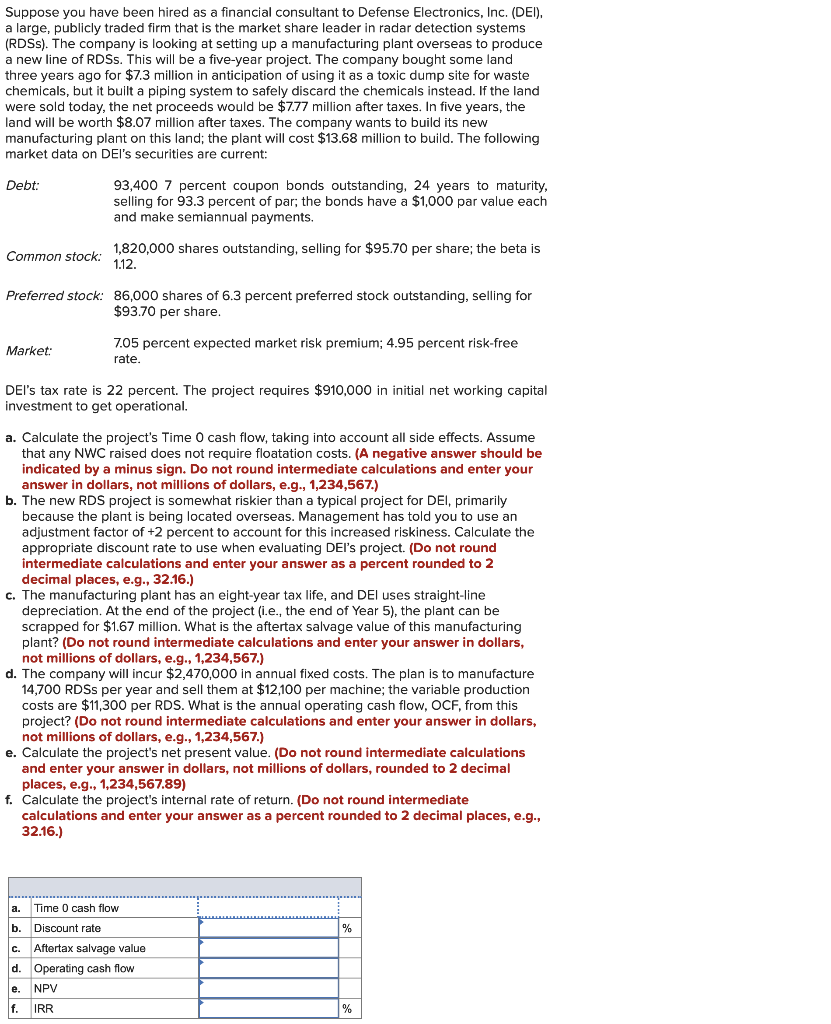
Suppose you have been hired as a financial consultant to Defense Electronics, Inc. (DEI). a large, publicly traded firm that is the market share leader in radar detection systems (RDSS). The company is looking at setting up a manufacturing plant overseas to produce a new line of RDSs. This will be a five-year project. The company bought some land three years ago for $7.3 million in anticipation of using it as a toxic dump site for waste chemicals, but it built a piping system to safely discard the chemicals instead. If the land were sold today, the net proceeds would be $7.77 million after taxes. In five years, the land will be worth $8.07 million after taxes. The company wants to build its new manufacturing plant on this land; the plant will cost $13.68 million to build. The following market data on DEI's securities are current: Debt: 93,400 7 percent coupon bonds outstanding, 24 years to maturity, selling for 93.3 percent of par; the bonds have a $1,000 par value each and make semiannual payments. Common stock: 1,820,000 shares outstanding, selling for $95.70 per share; the beta is 1.12. Preferred stock: 86,000 shares of 6.3 percent preferred stock outstanding, selling for $93.70 per share. Market: 7.05 percent expected market risk premium; 4.95 percent risk-free rate. DEI's tax rate is 22 percent. The project requires $910,000 in initial net working capital investment to get operational. because the a. Calculate the project's Time O cash flow, taking into account all side effects. Assume that any NWC raised does not require floatation costs. (A negative answer should be indicated by a minus sign. Do not round intermediate calculations and enter your answer in dollars, not millions of dollars, e.g., 1,234,567.) b. The new RDS project is somewhat riskier than a typical project for DEI, primarily is being located overseas. Management has told you to use an adjustment factor of +2 percent to account for this increased riskiness. Calculate the appropriate discount rate to use when evaluating Del's project. (Do not round intermediate calculations and enter your answer as a percent rounded to 2 decimal places, e.g., 32.16.) C. The manufacturing plant has an eight-year tax life, and DEI uses straight-line depreciation At the end of the project (i.e., the end of Year 5), the plant can be scrapped for $1.67 million. What is the aftertax salvage value of this manufacturing plant? (Do not round intermediate calculations and enter your answer in dollars, not millions of dollars, e.g., 1,234,56 d. The company will incur $2,470,000 in annual fixed costs. The plan is to manufacture 14,700 RDSS per year and sell them at $12,100 per machine; the variable production costs are $11,300 per RDS. What is the annual operating cash flow, OCF, from this project? (Do not round intermediate calculations and enter your answer in dollars, not millions of dollars, e.g., 1,234,567.) e. Calculate the project's net present value. (Do not round intermediate calculations and enter your answer in dollars, not millions of dollars, rounded to 2 decimal places, e.g., 1,234,567.89) f. Calculate the project's internal rate of return. (Do not round intermediate calculations and enter your answer as a percent rounded to 2 decimal places, e.g., 32.16.) % a. Time cash flow b. Discount rate Aftertax salvage value d. Operating cash flow e. NPV f. IRR % Suppose you have been hired as a financial consultant to Defense Electronics, Inc. (DEI). a large, publicly traded firm that is the market share leader in radar detection systems (RDSS). The company is looking at setting up a manufacturing plant overseas to produce a new line of RDSs. This will be a five-year project. The company bought some land three years ago for $7.3 million in anticipation of using it as a toxic dump site for waste chemicals, but it built a piping system to safely discard the chemicals instead. If the land were sold today, the net proceeds would be $7.77 million after taxes. In five years, the land will be worth $8.07 million after taxes. The company wants to build its new manufacturing plant on this land; the plant will cost $13.68 million to build. The following market data on DEI's securities are current: Debt: 93,400 7 percent coupon bonds outstanding, 24 years to maturity, selling for 93.3 percent of par; the bonds have a $1,000 par value each and make semiannual payments. Common stock: 1,820,000 shares outstanding, selling for $95.70 per share; the beta is 1.12. Preferred stock: 86,000 shares of 6.3 percent preferred stock outstanding, selling for $93.70 per share. Market: 7.05 percent expected market risk premium; 4.95 percent risk-free rate. DEI's tax rate is 22 percent. The project requires $910,000 in initial net working capital investment to get operational. because the a. Calculate the project's Time O cash flow, taking into account all side effects. Assume that any NWC raised does not require floatation costs. (A negative answer should be indicated by a minus sign. Do not round intermediate calculations and enter your answer in dollars, not millions of dollars, e.g., 1,234,567.) b. The new RDS project is somewhat riskier than a typical project for DEI, primarily is being located overseas. Management has told you to use an adjustment factor of +2 percent to account for this increased riskiness. Calculate the appropriate discount rate to use when evaluating Del's project. (Do not round intermediate calculations and enter your answer as a percent rounded to 2 decimal places, e.g., 32.16.) C. The manufacturing plant has an eight-year tax life, and DEI uses straight-line depreciation At the end of the project (i.e., the end of Year 5), the plant can be scrapped for $1.67 million. What is the aftertax salvage value of this manufacturing plant? (Do not round intermediate calculations and enter your answer in dollars, not millions of dollars, e.g., 1,234,56 d. The company will incur $2,470,000 in annual fixed costs. The plan is to manufacture 14,700 RDSS per year and sell them at $12,100 per machine; the variable production costs are $11,300 per RDS. What is the annual operating cash flow, OCF, from this project? (Do not round intermediate calculations and enter your answer in dollars, not millions of dollars, e.g., 1,234,567.) e. Calculate the project's net present value. (Do not round intermediate calculations and enter your answer in dollars, not millions of dollars, rounded to 2 decimal places, e.g., 1,234,567.89) f. Calculate the project's internal rate of return. (Do not round intermediate calculations and enter your answer as a percent rounded to 2 decimal places, e.g., 32.16.) % a. Time cash flow b. Discount rate Aftertax salvage value d. Operating cash flow e. NPV f. IRR %







